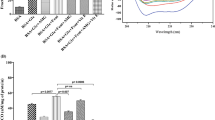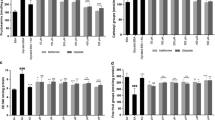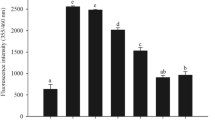Abstract.
Hyperglycemia increases oxidative stress in various tissues and leads to diabetic cardiovascular complication. Dyslipidemia, such as an increase in oxidized low-density lipoprotein (LDL), is well recognized in diabetic patients with hyperglycemia. However, the mechanism by which hyperglycemia causes the increased LDL oxidation remains unclear. Albumin is the most abundant protein in the circulation, and can function as an antioxidant. Therefore, we examined whether glycoxidative modification inhibits the antioxidant activity of albumin to LDL oxidation and clarified the mechanism by which this modification may suppress its antioxidant activity. Human serum albumin (HSA) was incubated in phosphate-buffered saline with and without glucose at 37°C for up to 8 weeks under aerobic conditions (referred to as glycoxidation (goHSA) and oxidation (oHSA), respectively). Metal chelator-treated, nonoxidative HSA (chHSA) and freshly prepared HSA (fHSA) were used as controls. N ε-(carboxymethyl)lysine (CML), a glycoxidative product, was determined by enzyme-linked immunosorbent assay. Oxidation was estimated by measuring the thiols of the HSA molecule. Copper-mediated oxidation of LDL was conducted in the presence or absence of modified HSAs at 37°C for 6 days. Malondialdehyde and negative charge of LDL were measured. To clarify the mechanism of reduced antioxidant activity of HSA, we examined firstly the binding activity of modified HSAs to copper, and secondly the effects of free radical scavengers on the formation of malondialdehyde. CML was formed in goHSA in a time- and concentration-dependent manner. Both goHSA and oHSA significantly decreased the contents of free thiol groups compared to ch- and fHSAs. The antioxidant activity of goHSA to LDL oxidation was the lowest among various modified HSAs. The oHSA showed a moderate decrease in antioxidant activity. The binding activity of go- and oHSAs to copper was lower than that of ch- and fHSAs. The formation of MDA from LDL oxidation in the presence of goHSA was completely inhibited by Tiron (1,2-dihydroxy-3,5-benzenedisulfonic acid) and superoxide dismutase. In contrast, catalase and mannitol had no effect. Our results indicate that in vitro glycoxidation of HSA induced a marked loss of antioxidant activity of this molecule to copper-mediated oxidation of LDL, which may be caused by the generation of superoxide.
Similar content being viewed by others
Author information
Authors and Affiliations
Additional information
Received: December 17, 2001 / Accepted: June 28, 2002
Acknowledgments The authors thank Drs. Ryoji Nagai and Seikoh Horiuchi (Department of Biochemistry, Kumamoto University School of Medicine, Kumamoto, Japan) and Drs. Hiroyuki Itabe and Tatsuya Takano (Department of Microbiology and Molecular Pathology, Faculty of Pharmaceutical Sciences, Teikyo University, Sagamiko, Kanagawa, Japan) for kindly supplying antibodies. We also thank Associate Professor Takeo Yamaguchi (Department of Chemistry, Faculty of Science, Fukuoka University) for the ESR experiment and Miss Satoko Nagano for her excellent technical assistance. This work was supported by a Grant-in-Aid from the Ministry of Education, Science, Sports and Culture of Japan (No. 14570171) and in part by funds from the Central Research Institute of Fukuoka University (No. 016004).
Correspondence to N. Sakata
Rights and permissions
About this article
Cite this article
Sakata, N., Moh, A. & Takebayashi, S. Contribution of superoxide to reduced antioxidant activity of glycoxidative serum albumin. Heart Vessels 17, 22–29 (2002). https://doi.org/10.1007/s003800200038
Issue Date:
DOI: https://doi.org/10.1007/s003800200038




